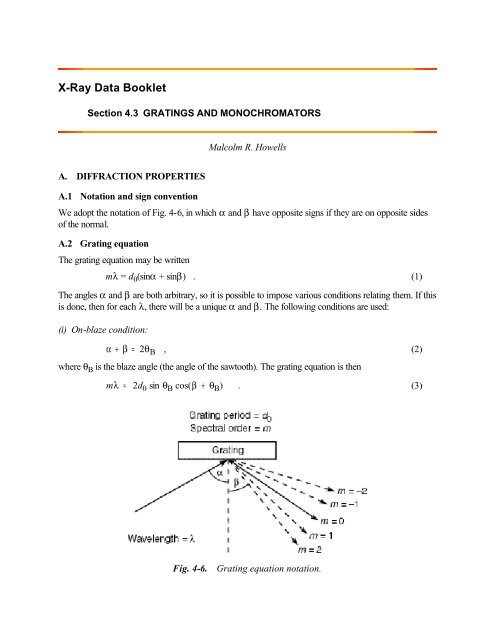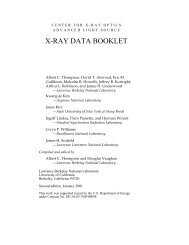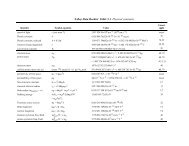original version printed in the x-ray data booklet
original version printed in the x-ray data booklet
original version printed in the x-ray data booklet
- No tags were found...
Create successful ePaper yourself
Turn your PDF publications into a flip-book with our unique Google optimized e-Paper software.
X-Ray Data BookletSection 4.3 GRATINGS AND MONOCHROMATORSMalcolm R. HowellsA. DIFFRACTION PROPERTIESA.1 Notation and sign conventionWe adopt <strong>the</strong> notation of Fig. 4-6, <strong>in</strong> which α and β have opposite signs if <strong>the</strong>y are on opposite sidesof <strong>the</strong> normal.A.2 Grat<strong>in</strong>g equationThe grat<strong>in</strong>g equation may be writtenmλ = d 0 (s<strong>in</strong>α + s<strong>in</strong>β) . (1)The angles α and β are both arbitrary, so it is possible to impose various conditions relat<strong>in</strong>g <strong>the</strong>m. If thisis done, <strong>the</strong>n for each λ, <strong>the</strong>re will be a unique α and β. The follow<strong>in</strong>g conditions are used:(i) On-blaze condition:α + β = 2θ B , (2)where θ B is <strong>the</strong> blaze angle (<strong>the</strong> angle of <strong>the</strong> sawtooth). The grat<strong>in</strong>g equation is <strong>the</strong>nmλ = 2d 0 s<strong>in</strong> θ B cos(β + θ B ) . (3)Fig. 4-6. Grat<strong>in</strong>g equation notation.
(ii) Fixed <strong>in</strong> and out directions:α − β = 2θ , (4)where 2θ is <strong>the</strong> (constant) <strong>in</strong>cluded angle. The grat<strong>in</strong>g equation is <strong>the</strong>nmλ = 2d 0 cosθs<strong>in</strong>( θ + β) . (5)In this case, <strong>the</strong> wavelength scan ends when α or β reaches 90°, which occurs at <strong>the</strong> horizonwavelength λ H = 2d 0 cos 2 θ.(iii) Constant <strong>in</strong>cidence angle: Equation (1) gives β directly.(iv) Constant focal distance (of a plane grat<strong>in</strong>g):lead<strong>in</strong>g to a grat<strong>in</strong>g equationcos βcosα = a constant c ff , (6)⎛1 – ⎜mλ⎝ d– s<strong>in</strong> β⎞⎟⎠2=cos 2 βc ff2. (7)Equations (3), (5), and (7) give β (and <strong>the</strong>nce α) for any λ. Examples of <strong>the</strong> above α-βrelationships are (for references see http://www-cxro.lbl.gov/):(i) Kunz et al. plane-grat<strong>in</strong>g monochromator (PGM), Hunter et al. double PGM, collimated-lightSX700 PGM(ii) Toroidal-grat<strong>in</strong>g monochromators (TGMs), spherical-grat<strong>in</strong>g monochromators (SGMs, “Dragon”system), Seya-Namioka, most aberration-reduced holographic SGMs, variable-angle SGM,PGMs(iii) Spectrographs, “Grasshopper” monochromator(iv) Standard SX700 PGM and most variantsB. FOCUSING PROPERTIESThe study of diffraction grat<strong>in</strong>gs (for references see http://www-cxro.lbl.gov/) goes back more than acentury and has <strong>in</strong>cluded plane, spherical [1], toroidal, and ellipsoidal surfaces and groove patternsmade by classical (“Rowland”) rul<strong>in</strong>g [2], holography [3,4], and variably spaced rul<strong>in</strong>g [5,6]. In recentyears <strong>the</strong> optical design possibilities of holographic groove patterns and variably spaced rul<strong>in</strong>gs havebeen extensively developed. Follow<strong>in</strong>g normal practice, we provide an analysis of <strong>the</strong> imag<strong>in</strong>gproperties of grat<strong>in</strong>gs by means of <strong>the</strong> path function F [7]. For this purpose we use <strong>the</strong> notation of Fig.4-7, <strong>in</strong> which <strong>the</strong> zeroth groove (of width d 0 ) passes through <strong>the</strong> grat<strong>in</strong>g pole O, while <strong>the</strong> nth groovepasses through <strong>the</strong> variable po<strong>in</strong>t P(ξ,w,l). The holographic groove pattern is taken to be made us<strong>in</strong>gtwo coherent po<strong>in</strong>t sources C and D with cyl<strong>in</strong>drical polar coord<strong>in</strong>ates (r C ,γ,z C ), (r D ,δ,z D ) relative toO. The lower (upper) sign <strong>in</strong> Eq. (9) refers to C and D both real or both virtual (one real and onevirtual), for which case <strong>the</strong> equiphase surfaces are confocal hyperboloids (ellipses) of revolution about
CD. Grat<strong>in</strong>gs with varied l<strong>in</strong>e spac<strong>in</strong>g d(w) are assumed to be ruled accord<strong>in</strong>g to d(w) = d 0 (1 + v 1 w +v 2 w2 + ...).Fig. 4-7. Focus<strong>in</strong>g properties notation.We consider all <strong>the</strong> grat<strong>in</strong>gs to be ruled on <strong>the</strong> general surfacex =∑ija ij w i l jand <strong>the</strong> a ij coefficients are given below.Ellipse coefficients a ija 20 =cosθ4⎛ 1r + 1 ⎞⎝ r ′ ⎠a 12 =a 30 = a 20 A a 22 =a 40 =a 20 ( 4 A2 + C)4a 04 =a 20 Acos 2 θa 20 ( 2 A 2 + C)2cos 2 θa 20 C8cos 2 θa 02 =a 20cos 2 θThe o<strong>the</strong>r a ij ’s with i + j ≤ 4 are zero. In <strong>the</strong> expressions above, r, r ′ , and θ are <strong>the</strong> object distance,image distance, and <strong>in</strong>cidence angle to <strong>the</strong> normal, respectively, andA = s<strong>in</strong> θ2⎛ 1r – 1 ⎞⎝ r ′ ⎠, C = A 2 +1r r ′.
Toroid coefficients a ija 20 =a 40 =12Ra 22 =18R 3 a 04 =14ρR 218ρ 3a 02 =12ρO<strong>the</strong>r a ij ’s with i + j ≤ 4 are zero. Here, R and ρ are <strong>the</strong> major and m<strong>in</strong>or radii of <strong>the</strong> bicycle-tiretoroid.The a ij ’s for spheres; circular, parabolic, and hyperbolic cyl<strong>in</strong>ders; paraboloids; and hyperboloidscan also be obta<strong>in</strong>ed from <strong>the</strong> values above by suitable choices of <strong>the</strong> <strong>in</strong>put parameters r, r ′ , and θ .Values for <strong>the</strong> ellipse and toroid coefficients are given to sixth order at http://www-cxro.lbl.gov/.B.1 Calculation of <strong>the</strong> path function FF is expressed asF = ∑F ijk w i l j , (8)ijkwhereF ijk = z k C ijk (α ,r) + z ′ k C ijk (β, r ′ ) + mλ fd ijk0and <strong>the</strong> f ijk term, orig<strong>in</strong>at<strong>in</strong>g from <strong>the</strong> groove pattern, is given by one of <strong>the</strong> follow<strong>in</strong>g expressions:f ijk =⎧ 1 when ijk = 100, 0 o<strong>the</strong>rwise Rowland⎪⎪ d 0⎨ z k λ C C ijk (γ , r C ) ± z k D C ijk (δ, r D )0[ ] holographic⎪⎪⎩ n ijkvaried l<strong>in</strong>e spac<strong>in</strong>gThe coefficient F ijk is related to <strong>the</strong> strength of <strong>the</strong> i,j aberration of <strong>the</strong> wavefront diffracted by <strong>the</strong>grat<strong>in</strong>g. The coefficients C ijk and n ijk are given below, where <strong>the</strong> follow<strong>in</strong>g notation is used:andT = T (r,α ) =S = S(r,α ) =cos 2 αr– 2a 20 cosα (10a)1r – 2a 02 cosα . (10b)Coefficients C ijk of <strong>the</strong> expansion of F(9)
C 011 = – 1 rC 031 =C 100 = − s<strong>in</strong> αC 020 =S2C 022 = –S2r 2 C 040 =C 102 = s<strong>in</strong> α2r 2C 111 = − s<strong>in</strong> αr 2 C 120 =C 200 =T2S4r 2 – 12r 34a 2 02– S 28rSs<strong>in</strong> α2r− a 04 cosα– a 12 cosαC 202 = − T4r 2 + s<strong>in</strong> 2 α2r 3C 211 =T2r 2 − s<strong>in</strong> 2 αr 3C 300 = −a 30 cosα + T s<strong>in</strong> α2rC 220 = − a 22 cosα +1( 4r 4a 20 a 02 − TS − 2a 12 s<strong>in</strong> 2α )+ S s<strong>in</strong> 2 α2 r 2C 400 = −a 40 cosα +1(8r 4a 202 − T 2 − 4a 30 s<strong>in</strong> 2α )+ T s<strong>in</strong> 2 α2r 2The coefficients for which i ≤ 4, j ≤ 4, k ≤ 2, i + j + k ≤ 4,j + k = even are <strong>in</strong>cluded here.Coefficients n ijk of <strong>the</strong> expansion of Fn ijk = 0 for j, k ≠ 0n 100 = 1 n 300 =v 1 2 − v 23n 200 =−v 12n 400 =−v 1 3 + 2v 1 v 2 − v 34Values for C ijk and n ijk are given to sixth order at http://www-cxro.lbl.gov/.B.2 Determ<strong>in</strong>ation of <strong>the</strong> Gaussian image po<strong>in</strong>tBy def<strong>in</strong>ition <strong>the</strong> pr<strong>in</strong>cipal <strong>ray</strong> AOB 0 arrives at <strong>the</strong> Gaussian image po<strong>in</strong>t B 0 ( r 0 ′ , β 0 , z ′ 0 ) <strong>in</strong> Fig. 4-7. Itsdirection is given by Fermat’s pr<strong>in</strong>cipal, which implies [∂F/∂w] w=0,l=0 = 0 and [∂F/∂l] w=0,l=0 = 0, fromwhichandmλd 0= s<strong>in</strong> α + s<strong>in</strong> β 0 (11a)
zr + z ′ 0= 0 , (11b)r 0 ′which are <strong>the</strong> grat<strong>in</strong>g equation and <strong>the</strong> law of magnification <strong>in</strong> <strong>the</strong> vertical direction. The tangential focaldistance r 0 ′ is obta<strong>in</strong>ed by sett<strong>in</strong>g <strong>the</strong> focus<strong>in</strong>g term F 200 equal to zero and is given byT (r,α ) + T ( r 0 ′ , β 0 ) =⎧0⎪Rowland⎪⎨ – mλ [T(rλ C ,γ ) ±T(r D ,δ)]⎪ 0holographic⎪ v l mλ⎩⎪varied l<strong>in</strong>e spac<strong>in</strong>gd 0Equations (11) and (12) determ<strong>in</strong>e <strong>the</strong> Gaussian image po<strong>in</strong>t B 0 and, <strong>in</strong> comb<strong>in</strong>ation with <strong>the</strong> sagittalfocus<strong>in</strong>g condition (F 020 = 0), describe <strong>the</strong> focus<strong>in</strong>g properties of grat<strong>in</strong>g systems under <strong>the</strong> paraxialapproximation. For a Rowland spherical grat<strong>in</strong>g <strong>the</strong> focus<strong>in</strong>g condition, Eq. (12), is⎛⎜ cos 2 α⎝ r− cosαR⎞⎠ +⎛⎜cos 2 β⎝ r 0 ′− cos βRwhich has important special cases: (i) plane grat<strong>in</strong>g, R = ∞ ,imply<strong>in</strong>gr 0 ′ = –r cos 2 α/cos 2 β = –r/c2ff(12)⎞⎟ = 0 , (13)⎠so that <strong>the</strong> focal distance and magnification are fixed if c ff is held constant; (ii) object and image on <strong>the</strong>Rowland circle, i.e., r = Rcosα , r 0 ′ = R cosβ , M = l; and (iii) β = 90° (Wadsworth condition). Thefocal distances of TGMs and SGMs, with or without mov<strong>in</strong>g slits, are also determ<strong>in</strong>ed us<strong>in</strong>g Eq. (13).B.3 Calculation of <strong>ray</strong> aberrationsIn an aberrated system, <strong>the</strong> outgo<strong>in</strong>g <strong>ray</strong> will arrive at <strong>the</strong> Gaussian image plane at a po<strong>in</strong>t B R displacedfrom <strong>the</strong> Gaussian image po<strong>in</strong>t B 0 by <strong>the</strong> <strong>ray</strong> aberrations ∆ y ′ and ∆ z ′ (Fig. 4-7). The latter are givenby∆ y ′ =r 0 ′ ∂Fcosβ 0 ∂w , ∆ z ′ = r 0 ′ ∂F∂l, (14)where F is to be evaluated for A = (r,α,z) and B = ( r 0 ′ ,β 0 , z 0 ′ ). By means of <strong>the</strong> expansion of F,<strong>the</strong>se equations allow <strong>the</strong> <strong>ray</strong> aberrations to be calculated separately for each aberration type:∆ y ′ ijk =r 0 ′Fcos β ijk iw i–1 l j , ∆ z ′ ijk = r 0 ′ F ijk w i jl j –1 . (15)0Moreover, provided <strong>the</strong> aberrations are not too large, <strong>the</strong>y are additive, so that <strong>the</strong>y may ei<strong>the</strong>rre<strong>in</strong>force or cancel.
C. DISPERSION PROPERTIESDispersion properties can be summarized by <strong>the</strong> follow<strong>in</strong>g relations.(i) Angular dispersion:⎛⎜∂λ ⎞ ⎟⎝ ∂β ⎠α=d cosβm. (16)(ii) Reciprocal l<strong>in</strong>ear dispersion:⎛ ⎜ ∂λ ⎞=⎝ ∂(∆ y ′ ) ⎠ αd cosβm r ′≡ 10–3 d[Å]cosβm r ′ [m]Å/mm . (17)(iii) Magnification:M(λ) =cosαcos βr ′r. (18)(iv) Phase-space acceptance (ε):ε = N∆λ S1 = N∆λ S2 (assum<strong>in</strong>g S 2 = MS 1 ) , (19)where N is <strong>the</strong> number of participat<strong>in</strong>g grooves.D. RESOLUTION PROPERTIESThe follow<strong>in</strong>g are <strong>the</strong> ma<strong>in</strong> contributions to <strong>the</strong> width of <strong>the</strong> <strong>in</strong>strumental l<strong>in</strong>e spread function. Anestimate of <strong>the</strong> total width is <strong>the</strong> vector sum.(i) Entrance slit (width S 1 ):∆λ S1 =S 1 d cosαmr. (20)(ii) Exit slit (width S 2 ):∆λ S2 =S 2 d cosβm r ′. (21)(iii) Aberrations (of perfectly made grat<strong>in</strong>g):∆λ A =∆ y ′ d cos β=m r ′dm⎛ ∂F ⎞⎝ ∂w⎠. (22)(iv) Slope error ∆φ (of imperfectly made grat<strong>in</strong>g):
∆λ SE =d(cosα + cos β)∆φm. (23)Note that, provided <strong>the</strong> grat<strong>in</strong>g is large enough, diffraction at <strong>the</strong> entrance slit always guarantees acoherent illum<strong>in</strong>ation of enough grooves to achieve <strong>the</strong> slit-width-limited resolution. In such case adiffraction contribution to <strong>the</strong> width need not be added to <strong>the</strong> above.E. EFFICIENCYThe most accurate way to calculate grat<strong>in</strong>g efficiencies is by <strong>the</strong> full electromagnetic <strong>the</strong>ory [8].However, approximate scalar-<strong>the</strong>ory calculations are often useful and, <strong>in</strong> particular, provide a way tochoose <strong>the</strong> groove depth h of a lam<strong>in</strong>ar grat<strong>in</strong>g. Accord<strong>in</strong>g to Bennett, <strong>the</strong> best value of <strong>the</strong> groovewidth-to-periodratio r is <strong>the</strong> one for which <strong>the</strong> usefully illum<strong>in</strong>ated area of <strong>the</strong> groove bottom is equal tothat of <strong>the</strong> top. The scalar-<strong>the</strong>ory efficiency of a lam<strong>in</strong>ar grat<strong>in</strong>g with r = 0.5 is given by Franks et al. asE 0 =R4⎡⎛ 4πh cosα1 + 2(1 – P) cos⎣ ⎢⎝ λ⎞⎠⎤+ (1 – P)2⎦ ⎥whereE m =P =⎧ Rm 2 π 2 [1 – 2 cosQ+ cos(Q – + δ)⎪⎪ + cos 2 Q + ] m = odd⎨⎪ R⎪ m 2 π 2 cos2 Q +m = even⎩4h tanαd 0,(24)Q ± =mπhd 0(tanα ± tan β) ,δ =2πh(cosα + cosβ ) ,λand R is <strong>the</strong> reflectance at graz<strong>in</strong>g angle α G β G ,whereα G =π2 − | α | and β G = π2 − | β | .REFERENCES1. H. G. Beutler, “The Theory of <strong>the</strong> Concave Grat<strong>in</strong>g,” J. Opt. Soc. Am. 35, 311 (1945).







